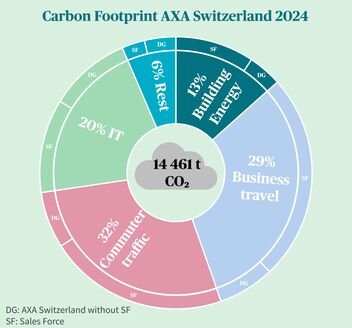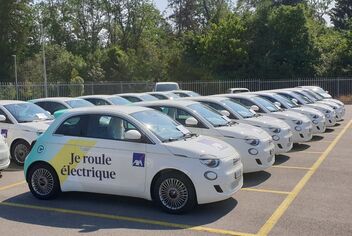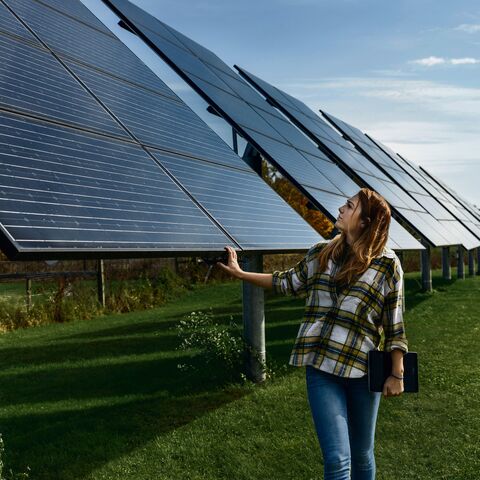
Climate strategy
AXA’s climate strategy has two main objectives: continually reducing CO2 and adapting to climate change. AXA intends to achieve these objectives in its role as insurer, investor, and company, as well as in its role as a member of society.
As an insurance company, we offer our customers products and services that promote more climate-friendly alternatives such as electromobility. As an investor, AXA aims to continuously reduce the carbon footprint of its investments. In its role as a company, AXA strives to reduce emissions from its operations and educate its employees about climate issues. For instance, all employees of AXA Insurance Ltd, AXA-ARAG and senior staff in the sales network are required to participate in a training session on the scientific principles of climate change and possible actions to reduce personal carbon emissions organized by the AXA Climate Academy. And as a corporate citizen, AXA enters into partnerships to protect what really matters, such as biodiversity in Switzerland with the Flora Futura initiative.
Our objective as a company: to contribute towards net zero
AXA Switzerland aims to continually reduce the carbon footprint of its operating business. We also aim to support effective and innovative climate protection projects to help reach the net zero target by 2050 and to limit global warming. We are going forward step by step so that we can implement this plan.
1. Calculating carbon emissions
Together with ClimatePartner, we are establishing on an annual basis the source and extent of the carbon emissions that our business generates. We include the carbon output of the 340 sales offices in this calculation. The carbon footprint helps us to identify reduction potential and develop measures.

Carbon footprint of AXA Switzerland 2024
Mobility currently accounts for around 60 percent of carbon emissions. In terms of commuter traffic and business travel, car journeys are responsible for most of the emissions. The impact on the climate due to energy consumption, which accounts for 13 percent of the carbon footprint, derives mainly from heating buildings. In the IT category (20 percent), the procurement of electronic equipment, such as computer screens or laptops, is the main factor. The remaining category comprises carbon emissions generated by working from home as well as paper consumption and waste.
2. Setting carbon reduction targets
In terms of energy consumption (direct and indirect emissions through purchased energy – Scope 1 and Scope 2 under the Greenhouse Gas Protocol) , we aim to reduce carbon emissions by 24 percent by 2025 and by 50 percent by 2030 compared to 2019. In terms of business travel, we are aiming to reduce carbon emissions by 21 percent by 2025 and by 40 percent by 2030 compared to 2019. These carbon reduction targets relate to AXA Switzerland excluding the sales team. We also aim to reduce IT-related carbon emissions by 21 percent by 2025 compared to 2020.
3. Implementing measures
As part of our climate strategy and in order to reach our carbon reduction targets, we are developing and constantly implementing reduction measures. The key measures focus on mobility and energy.
Climate-friendly mobility
We have internal travel guidelines to encourage our employees to travel in an eco-friendly way and to take the train rather than fly or drive. AXA supports the use of public transportation by reimbursing employees who buy a transit fare card, for example. Many AXA office buildings have bicycle parking and electric charging stations that employees can use to charge their car for free. AXA additionally offers financial support or solutions to its employees who travel the most to encourage them to switch to electromobility.
Thanks to Smart Working, our employees can work flexibly from home, in the office, or elsewhere. This way, commuting journeys are saved which has a positive impact on our carbon footprint.

Small electric cars for the AXA Switzerland sales team
Energy-efficient buildings and renewable energy
As a member of the Zurich Energy Model, AXA has been successfully implementing measures to improve energy efficiency in office buildings since 2010. We are also reducing office spaces and optimizing their usage. As a further step towards combating climate change, we are replacing heating systems that use fossil fuels with more environmentally-friendly alternatives such as district heating.
Since 2009, AXA has been drawing its electricity from renewable energy sources, mostly from Swiss hydropower. We also produce our own electricity with photovoltaic systems on our office buildings in Winterthur, Lausanne, and Lugano.
4. Supporting climate protection projects
In addition to reducing carbon emissions in our own value creation chain, AXA is supporting climate protection projects that remove and store CO₂ from the atmosphere over the long term. Removing CO₂ is essential for achieving the global net zero target. We have been working mainly with partners who remove and store carbon using nature-based methods, such as reforesting woods or producing Biochar from scrap wood, since 2021 and plan to continue doing so until 2025. As part of the AXA Group, we will be investing further in supporting nature-based climate protection projects until 2030. Technological solutions are still currently in their infancy, but play an important role for the global net zero target due to their long-term storage capacity. As a result, we have entered into two more partnerships for the period 2026 - 2030 in order to promote future-oriented technologies for carbon removal.
The young company Neustark will have removed and stored on a long-term basis 1,800 tons of carbon by 2030. Neustark has developed a technology that captures carbon in its biogas facilities and stores it in demolition concrete. The German-Brazilian start-up InPlanet will have removed and stored a further 1,950 tons by 2028. InPlanet removes carbon by weathering certain types of rock. The company accelerates a natural process by spreading finely ground rock powder on agricultural land in Brazil.

Reforestation project Uruguay (©ClimatePartner)

Biochar as carbon storage (©carbonfuture)

Storing carbon from biogas facilities in demolition concrete (© Neustark)

InPlanet CEO and co-founder Felix Harteneck together with Country Manager Rudson Liduino (© InPlanet)
5. External validation
ClimatePartner reviews and certifies the above steps for AXA Switzerland's business. The certification and our contribution to climate protection can be clearly tracked on the related Climate-ID website.

ClimatePartner-Label for the certification of climate protection in operating business

